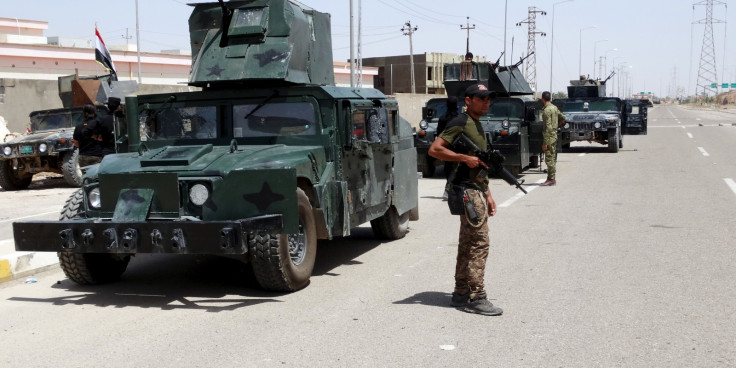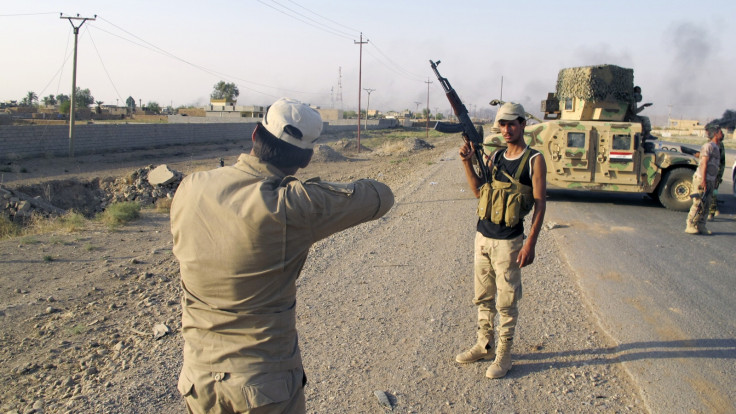Islamic State: Shia militias mass on Ramadi outskirts as IS gets ready for bloody fight to the death

Islamic State's seizure of the western Iraqi city of Ramadi drew immediate parallels to the group's victory in Mosul last June, where Iraqi army units ditched their weapons and fled, leaving the northern city to the mercy of the terrorist Sunni group.
Footage quickly emerged yesterday of Iraqi forces fleeing Ramadi, 60 miles west of Baghdad in hummers, along with thousands of refugees. District of Anbar officials said that at least 500 people had been killed in a wave of suicide bombings and that all Iraqi security bases had been abandoned.
But, unlike Mosul, Ramadi has tens of thousands of Shia militias massed on its borders, ready to enter the city and fight street-by-street alongside the Iraqi army as it recently did in Tikrit. These include Hashed al-Shaabi, known as the People's Mobilisation units, and Kataeb Hezbollah, both of which helped liberate Saddam Hussein's home city last month.
President Haidar al-Abadi had so far resisted calls from the militias to allow them to enter Anbar, a Sunni stronghold with little or no Shia presence, but reports Monday suggest that Baghdad cannot win back Ramadi without them. A spokesman for Ketaeb Hezbollah told AFP that his organisation had units ready to join the Ramadi front from three directions.

Ramadi is far from a functioning city, having been embroiled in a Sunni insurgency against Baghdad even before IS supremo Abu Bakr al-Baghdadi declared the caliphate in Iraq and Syria last year. Iraqi government forces held three key buildings in a decimated city that most civilians had already fled. IS will be aware that it is unlikely to hold Ramadi for long.
As in Tikrit, while the IS forces await the Shia onslaught they will be filling its streets with roadside bombs, IEDs and booby-traps, mounting snipers on rooftops and digging tunnels. The radical group know that by numbers alone they will eventually lose the city, their intention will be to make it as bloody and violent as possible.
"They are going to make the taking of the city so arduous and so expensive that they maximise casualties, maximise waste of resources and cause diversions from other areas. That will be the real effect of taking Ramadi strategically," said Aaron Balshan, an intelligence analyst at the Tel Aviv-based consultancy Levantine Group.
It is not a surprise that al-Abadi has hesitated so long in allowing the Shia militias to enter. While Tikrit was recaptured with a minimum of sectarian reprisals on the part of the Shiite fighters against ordinary Iraq Sunni civilians, Ramadi and Anbar's existence as a hotbed of Sunni fanaticism far predates IS and is ingrained in many of the region's most powerful tribes.
During the Iraq war, Fallujah and Anbar saw some of the bloodiest battles between the US army and Sunni insurgents, with a total of 1,335 Americans killed in the so-called Sunni Triangle around Fallujah and Ramadi. As far back as 2006, more extreme Sunni tribes have sided with terrorist groups including al-Qaeda against coalition forces and government troops.
In 2012 a powerful Anbari tribe began organising anti-government protests that by the end of 2013 had developed into violent uprising. At the beginning of 2014, thousands of Iraqis living in Ramadi and Fallujah had fled the region in the face of open warfare between Sunni militant groups and the Iraqi security forces that had already left swathes of the cities in ruins.
IS propaganda machine suggests: 'We have taken the city, you better run.'
While the replacement of the divisive and overtly sectarian rule of Noor al-Maliki with Haidar al-Abadi, as well as the successful taking of Tikrit, may have assuaged the fears among some Sunnis in Anbar of the government in Baghdad, tensions still run high in the province.
The same Sunni tribes that fought the Americans and then the Iraqi government with such ferocity over the past 15 years may be unwilling to see between 6,000 and 10,000 pro-Iranian Shia fighters storming through their tribal homeland.

"It is an extremely dangerous dynamic [...] and points to the contradiction at the heart of the anti-IS strategy – that you are relying on the same groups to beat IS [as that] inflame tensions," said Julien Barnes-Dacey, a senior policy fellow, European Council on Foreign Relations (ECFR).
That said, if the fall of Ramadi at the end of last week demonstrates anything, it is that the Iraqi army cannot take back cities from IS without the help of the Shia militias.
The footage showing Iraqi soldiers fleeing another city in the face of an IS onslaught is a propaganda win for a public-relations savvy Islamic State, which has not only bolstered its image by winning Ramadi but shown how it can use the media as a strategic tool in future.
"IS operated the same way in April, when it erroneously reported that parts of [Ramadi] had fallen to ISIS. That led to false reporting and stirred up a lot of instability in the city that only served to gain IS," said Balshan.
"Now we're seeing pictures of ISF soldiers fleeing in hummers and leaving their weapons behind and a lot of that has to do with the IS propaganda machine. It suggests: 'We have taken the city, you better run.' It causes a panic."
© Copyright IBTimes 2025. All rights reserved.






















